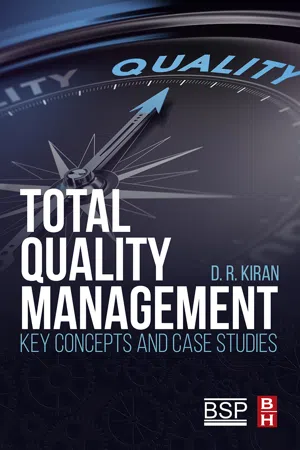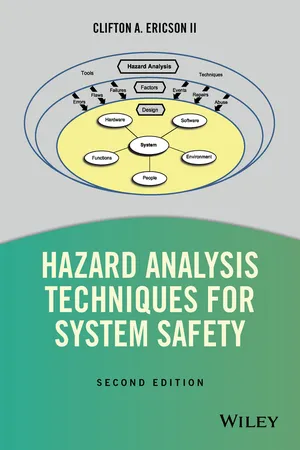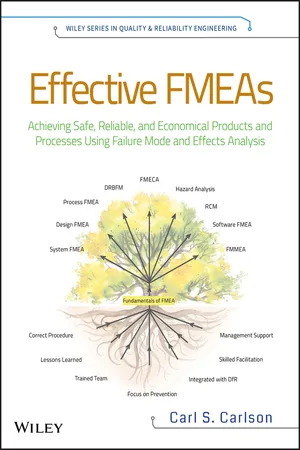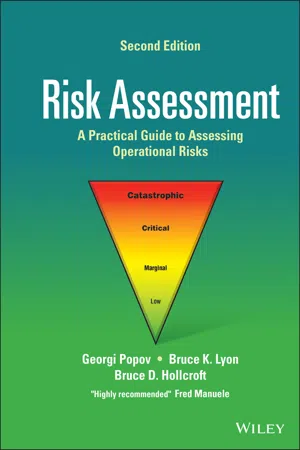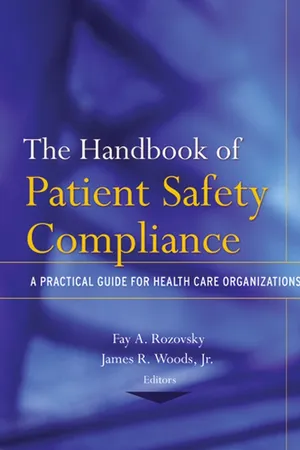Technology & Engineering
FMEA Risk Analysis
FMEA (Failure Mode and Effects Analysis) Risk Analysis is a systematic method for identifying and prioritizing potential failure modes in a process, product, or system. It involves assessing the severity, occurrence, and detection of each failure mode to determine its overall risk priority. This analysis helps organizations proactively address potential issues and improve the reliability and safety of their products or processes.
Written by Perlego with AI-assistance
Related key terms
Related key terms
1 of 4
Related key terms
1 of 3
12 Key excerpts on "FMEA Risk Analysis"
- eBook - ePub
Total Quality Management
Key Concepts and Case Studies
- D.R. Kiran(Author)
- 2016(Publication Date)
- Butterworth-Heinemann(Publisher)
Every product or project undertaken by the engineer is an experiment because each stage of the design or development is experienced for the first time. There are uncertainties at every stage, and the engineer is bound to make presumptions, either from data, books, or from his experience. These uncertainties can be in the form of:• models used for the design calculations,• performance characteristics of the materials,• inconsistencies in the materials purchased,• nature of the pressure the finished product will encounter,• size of the product, whether a medium-sized product or a large-sized product,• volume of production, viz, batch production or mass production,• specialized materials and skills used in the manufacture.Apart from the above, the engineer may also experience uncertainties from the viewpoint of several other variables in the development.26.2 Failure Modes and Effects Analysis
Failure mode and effects analysis (FMEA) is one of the best management tools to analyze the potential failure modes within a system under conditions of uncertainties, as stated above. Its principle is quite basic, and has been practiced since the olden days as the trial and error method. But since learning from each failure is both costly and time-consuming, the modern form of FMEA was developed during the 1940s, as explained in the following section. It emphasizes the probability of occurrence of that failure, and the severity of its effect on the system of every uncertainty. It is used to identify potential failure modes, determine their effect on the operation of the product, and identify actions to mitigate the failures. It analyzes potential reliability problems early in the development cycle, where it is easier to take actions to overcome these issues, thereby, enhancing reliability through design. FMEA should always be done whenever failures would mean potential harm or injury to the user of the end item being designed. According to Besterfield et al., FMEA is a “before-the-event ” action requiring a team effort to easily and inexpensively alleviate changes in design and production - eBook - ePub
- Clifton A. Ericson(Author)
- 2015(Publication Date)
- Wiley(Publisher)
Chapter 16 Failure Mode and Effects Analysis16.1 FMEA Introduction
Failure mode and effects analysis (FMEA) is a tool for evaluating the effect(s) of potential failure modes of subsystems, assemblies, components, or functions. It is primarily a reliability tool to identify failure modes that would adversely affect the overall system reliability. FMEA has the capability to include failure rates for each failure mode, in order to achieve a quantitative probabilistic analysis. Additionally, the FMEA can be extended to evaluate failure modes that may result in an undesired system state, such as a system hazard, and thereby also be used for hazard analysis.A more detailed version of the FMEA is known as failure mode, effects, and criticality analysis (FMECA). The FMECA requires that more information be obtained from the analysis, particularly information dealing with the criticality and detection of the potential failure modes.FMEA is a disciplined bottom-up evaluation technique that focuses on the design or function of products and processes, in order to prioritize actions to reduce the risk of product or process failures. In addition, the FMEA is a tool for documenting the analysis and capturing recommended design changes. Time and resources for a comprehensive FMEA must be allotted during design and process development, when design and process changes can most easily and inexpensively be implemented.16.2 FMEA Background
FMEA falls under the detailed design hazard analysis type (DD-HAT) because it is an analysis done at the component or functional level based on detailed system design. The basic hazard analysis types are described in Chapter 4 .An alternate name for this technique is FMECA. FMECA is basically the same as FMEA, except that it adds criticality evaluation to each failure mode, as well as the evaluation of possible failure mode detection methods. - eBook - ePub
Effective FMEAs
Achieving Safe, Reliable, and Economical Products and Processes using Failure Mode and Effects Analysis
- Carl S. Carlson(Author)
- 2012(Publication Date)
- Wiley(Publisher)
Chapter 3 Understanding the Fundamental Definitions and Concepts of FMEAs Intellectuals solve problems, geniuses prevent them. —Albert EinsteinIN THIS CHAPTER
What exactly is Failure Mode and Effects Analysis (FMEA) and what are its key concepts and definitions? This chapter explains the different types of FMEAs and tells how each is used. The majority of the chapter covers a thorough explanation of the key words and concepts of FMEA, each illustrated with multiple application examples for different types of FMEAs.3.1 DEFINITION OF FMEA
Failure Mode and Effects Analysis (FMEA) is a method designed to:- Identify and fully understand potential failure modes and their causes, and the effects of failure on the system or end users, for a given product or process.
- Assess the risk associated with the identified failure modes, effects, and causes, and prioritize issues for corrective action.
- Identify and carry out corrective actions to address the most serious concerns.
An FMEA is an engineering analysis done by a cross-functional team of subject matter experts that thoroughly analyzes product designs or manufacturing processes early in the product development process. Its objective is finding and correcting weaknesses before the product gets into the hands of the customer.An FMEA should be the guide to the development of a complete set of actions that will reduce risk associated with the system, subsystem, and component or manufacturing/assembly process to an acceptable level.Performing an FMEA just to fill a checkbox in the Product Development Process and then filing it away, never to be seen again, is a waste of time and adds no value. If not for use as guidance through the development process, why waste the time and resources to do it in the first place? If effectively used throughout the product life cycle, it will result in significant improvements to reliability, safety, quality, delivery, and cost. - eBook - ePub
Risk Assessment
A Practical Guide to Assessing Operational Risks
- Georgi Popov, Bruce K. Lyon, Bruce D. Hollcroft(Authors)
- 2021(Publication Date)
- Wiley(Publisher)
8 Failure Mode and Effects Analysis Georgi Popov1 and Bruce Lyon2 1 University of Central Missouri 2 Brown & BrownOBJECTIVES
- Introduction, Overview, and Background
- Purpose and Use
- Practical Application
- Examples
- Practice Exercises/Questions
8.1 Introduction
Failure Mode and Effects Analysis (FMEA) is one of the most commonly used techniques for hazard analysis and risk assessment. As its name implies, FMEA is used to identify and analyze the ways in which system components can fail to fulfill their designed intent, and the resulting effects to the system. To state plainly, FMEA focusses on failures and their effects to understand how each failure can be prevented and their effects reduced. It is generally considered a qualitative or semiquantitative method that lists systematically the failure modes, their effects, existing safeguards, and any additional controls that are needed to reduce risk to an acceptable level.Traditionally, the FMEA method has been used as a form of “reliability” analysis of systems, subsystems, processes, and hardware. However, FMEA can also be used to analyze jobs and individual tasks, to identify potential deviations from desired performance criteria that can cause failures (exposure to hazards), how these failures can occur, and their resulting effect on the workers, as well as the work environment. This chapter will address the practical use of the FMEA technique in identifying failure modes and their effects, existing control measures, and ranking systems according to their importance or criticality. The text will provide qualitative and semiquantitative information for additional analytical techniques such as Bow‐Tie analysis.FMEA, one of the first failure analysis methods, was developed by the United States (US) Department of Defense (DoD) in 1949. It was originally published in the Military Procedure, MIL‐P‐1629 – Procedures for performing a failure mode effect and critical analysis, - eBook - ePub
System Health Management
with Aerospace Applications
- Stephen B. Johnson, Thomas J. Gormley, Seth S. Kessler, Charles D. Mott, Ann Patterson-Hine, Karl M. Reichard, Philip S. Scandura, Stephen B Johnson, Thomas Gormley, Seth Kessler, Charles Mott, Ann Patterson-Hine, Karl Reichard, Philip Scandura(Authors)
- 2011(Publication Date)
- Wiley(Publisher)
Purpose: Failure modes and effects analysis (FMEA) is an engineering process that investigates the potential effects of postulated failures on a system and its environment. When the criticality of the effects is also considered, the technique is called a failure modes and effects criticality analysis (FMECA). FMEA and FMECA are widely used to discover design defects during development of a system and to troubleshoot problems during system operation.Background: FMEA was developed in the late 1950s and 1960s to provide a systematic form of failure analysis that could improve reliability. Its use has been embraced by a broad range of industries including device designers, aerospace, automotive, manufacturing, and chemical processing. The earliest organizations to set standards on FMEA were NASA in 1971 and the US military in 1974 (Lutz and Woodhouse, 1999).Process: The input to FMEA is a design description of the system or component. After determining the scope of the analysis (what components and what level of detail are appropriate), the analyst identifies the failure modes of each component. Depending on the scope of the analysis and type of system, these failure modes may include mechanical, electronic, electrical, software, environmental, and/or operational aspects of the system. Often the potential failure modes are drawn from preexisting libraries of known failure modes for each component. These guidewords (e.g., “rupture” or “short circuit”) provide a structured approach to the investigation. The probability of each failure mode is sometimes available from historical data or the manufacturer.After determining the failure modes, the analyst then determines the effect of each potential failure mode on the component (local effect) and on the system operating in its environment (global effect). Effects range from effects on the component itself (e.g., “leak”) to effects on the environment (e.g., “contamination”). - eBook - ePub
Aircraft System Safety
Assessments for Initial Airworthiness Certification
- Duane Kritzinger(Author)
- 2016(Publication Date)
- Woodhead Publishing(Publisher)
5Failure Modes and Effects Analysis
Abstract
An Failure Modes and Effects Analysis (FMEA) is a systematic ‘bottom-up’ method of (1) identifying single failure modes and failure probabilities of a system, item, function, or piece-part (i.e. smallest individual part or component); (2) determining the effects of this failure mode on the next higher level of the design (if available to the assessor, i.e. an LRU supplier will not know how much redundancy the system integrator is going to build into his system); and (3) classifying failure modes according to the worst case severity of the end effect.Keywords
Compensating provisions; Failure criticality; Failure detection method; Failure effect; Failure mode; FMEA; FMECA; Functional Block Diagram; Functional FMEA; Piece-part FMEA; Prioritise; Process FMEAFailure is the rule rather than the exception, and every failure contains information. Steve Wozniak (Apple co-founder)5.1. Introduction
In this chapter we explore the Failure Modes & Effects Analysis (FMEA) and the Failure Modes Effects & Criticality Analysis (FMECA) which, as the name suggests, simply is an extension of the FMEA.1 This chapter will use the acronym FMEA and highlight those instances where is extended to include FMECA.5.1.1. Background
An FMEA is a systematic ‘bottom-up ’ method of:• identifying single failure modes and failure probabilities of a system, item, function or piece-part (i.e. smallest individual part or component);• classifying failure modes according to the worst case severity of the end effect (FMECA only).• determining the effects of a failure mode on the next higher level of the design (if available to the assessor as an LRU supplier will not necessarily know how much redundancy the system integrator is going to build into his system);The FMEA approach has been around for a very long time. Before any documented format was developed, inventors and process experts would try to anticipate what could go wrong with a design or process before it was developed or tried. The FMEA discipline was first formalised in the late 1940s by the US Military (refer MIL-P-1629A - eBook - ePub
The Handbook of Patient Safety Compliance
A Practical Guide for Health Care Organizations
- Fay A. Rozovsky, James R. Woods, Fay A. Rozovsky, James R. Woods(Authors)
- 2016(Publication Date)
- Jossey-Bass(Publisher)
CHAPTER FOUR FAILURE MODES AND EFFECTS ANALYSIS : The Risks and the Rewards in Health Care Robert J. LatinoFailure modes and effects analysis … what a complex sounding and intimidating name! Although the FMEA methodology has been around for decades, it is relatively new to the health care world. The very name itself, failure modes and effects analysis, suggests that engineers had a hand in its original development. Engineers, known for their left-brain tendencies, are stereotyped as logical individuals who plan and structure everything. Seen through an engineer’s eyes, the world is a complex system in which the known sciences must apply to solve all problems.Contrast this to what engineers are not characteristically known for—that is their right-brain tendencies or the ability to be creative and think in the abstract or in concepts (versus the definitiveness of known science). Herein lies the crossroads at which FMEA meets health care. Recent efforts by the Joint Commission on Accreditation of Healthcare Organizations (JCAHO) attempt to utilize FMEA and apply it to health care systems. This is an admirable effort and, this author believes, a well-founded one. However, the cultural differences between industry and health care must be taken into consideration and accounted for in order for this initiative to be successful.Traditional FMEA Roots
Start with an understanding of the original intent of FMEA. It is a foundation for determining what modifications would be appropriate for FMEA in the health care environment. Consider that the FMEA technique was born in the aircraft industry, and FMEA is most widely known for its applicability to aircraft design. It has since been applied successfully to an array of equipment and systems issues in the continuous process and batch-processing industries. When designing an aircraft, aerospace engineers naturally are very interested in learning the answer to this question, What could be the effects on the equipment and the entire aircraft if a component would fail? It is important to emphasize the term could because traditional FMEA focuses on what might go wrong, not what has - eBook - ePub
Reliability Engineering
Methods and Applications
- Mangey Ram, Mangey Ram(Authors)
- 2019(Publication Date)
- CRC Press(Publisher)
12.6.2 Preparing the Worksheet for the Analysis and Reliability Assessment in FMEAe 12.6.3 Criticality Analysis of System of Figure 12.2 Applying the FMEAe Approach 12.7 Final Remarks References12.1 BACKGROUND FOR DEVELOPING THE EXPANDED FAILURE MODES AND EFFECTS ANALYSIS
There is significant experience in the field of systems reliability analysis. Here the Fault Tree Analysis (FTA) technique has played an important role due to its power for emphasizing some aspects that exert an enormous influence on the reliability of redundant systems, specifically those designed to operate with high availability and safety requirements.These analyses constitute a key support tool in decision-making process, which, in turn, are a crucial aspect when it concerns activities or processes in industrial facilities or services with significant hazards associated to the processes with which they deal [1 ].To determine the dominant contributors of the risk or the reliability of a system, detailed information needs to be adequately processed so that the proposed objective can be accomplished. However, the following difficulties are frequently present:• Not all the necessary information for a correct decision is always available • An important part of the information may be available, but not organized and processed in an appropriate mannerThe solution of these key problems can be achieved by:• Gathering the raw data of the facility, processing them adequately, and preparing a database oriented to reliability and safety, so that a specialized computer tool of reliability and risk analysis can use it in a proper manner• Training and qualifying specialists and managers in the use of these databases and specialized computer programs so that the data can be used correctly and decisions can produce the expected resultsTraining and qualifying the staff of an industry in the use of specialized programs in this field is not a major problem, or at least its solution can be ready in the short term, because there is currently a significant amount of experience in that field. - eBook - ePub
Failure Mode and Effect Analysis
FMEA From Theory to Execution
- D.H. Stamatis(Author)
- 2003(Publication Date)
- ASQ Quality Press(Publisher)
6 Design FMEAA design FMEA is a disciplined analysis/method of identifying potential or known failure modes and providing follow-up and corrective actions before the first production run occurs. A first production run is viewed as the run that generates a product or service for a specific customer with the intent of getting paid. This definition of the first run is very important because it excludes initial sample runs (ISR), trial runs, occasional prototype run(s), and so on. The threshold of the first production run is important, because up to that point modifying and/or changing the design is not a major problem. After that point, however, the customer gets involved through the letter of deviation, waiver of change, or some other kind of formal notification.A design or product FMEA usually is accomplished through a series of steps to include component, subsystems/subassemblies, and/or systems/assemblies. The design FMEA is an evolutionary process (dynamic as opposed to static) involving the application of various technologies and methods to produce an effective design output. This result will be used as an input for the process or assembly, and/or the service FMEA (see Chapter 5 , Figures 5.1 , 5.2 , and 5.3 ).Selection of appropriate technologies may include the utilization of existing system(s), standardized approaches currently known or proposed, results of directed research, results of the system FMEA, or a combination of all these factors.Effective design FMEA is basically realized through the system engineering process, product development, research and development (R&D), marketing, manufacturing, or a combination of all theseentities (Blanchard 1986). The focus in this stage is to minimize failure effects on the system, regardless of what level FMEA is being performed. - eBook - ePub
Reliability Culture
How Leaders Build Organizations that Create Reliable Products
- Adam P. Bahret(Author)
- 2021(Publication Date)
- Wiley(Publisher)
10 Risk Analysis Guided Project ManagementWe have limited resources and limited time. We would like to select and adhere to a method to choose where to apply resources. I firmly believe that assessed risk is the best way to do this. Using risk assessment to guide program activities is a process of:- Selecting tools that can translate product performance and program success risk to quantitative values.
- Use these values to prioritize the most critical areas of the product and program to address.
- Create a summary of these quantitative risk rankings that assigns specific tools to measure and mitigate these risks.
- Create a program plan that applies the available resources to these items in rank order until time and resources run out.
Failure Mode Effects Analysis Methodology
A Failure Mode Effects Analysis (FMEA ) looks to take speculative failure modes and their effects and make them quantifiable so that they can be ranked from highest to lowest risk. FMEAs can be used in programs for many purposes.I have noticed in my career that simply uttering the word FMEA creates a “cringe” in the room. I would believe that if I were to choose the phrase that best describes how many teams feel about FMEAs it would be what was said to me after I did a “lunch and learn.” “I get what you are saying about the value of FMEAs, but we have been a bit traumatized by them in the past.” Traumatized?! The team lead actually used the word “traumatized.”But that is not an uncommon experience and the negative effects are real. FMEAs are a true double‐edged sword. I sincerely believe they are one of the most valuable cornerstones to any reliability and product development program, if done correctly. Like anything else that is powerful, it's just as easy to cut off your own leg with it if you don't know what you are doing.Simply put, a badly run FMEA is something you would wish upon your competitors. It wastes time, drains morale, and doesn't provide any valuable program or design input. What more could you hope for for the other guy with a product next to yours on the store shelf? - eBook - ePub
- Bijan Elahi(Author)
- 2018(Publication Date)
- Academic Press(Publisher)
Table 12.1 to customize the criticality rankings to suit your organization. There is no reason why the matrix should be two dimensional. Addition of a third factor, e.g., Detectability, would make the matrix three dimensional. While graphical display of a 3-D matrix on a page may be less convenient, computers have no problem resolving and ranking criticalities based on your design of the criticality matrix.Table 12.1 Example criticality matrix12.4.6 Benefits of FMEA
Although in this book FMEAs are used for the benefit of safety risk management, there are many other advantages and benefit to FMEAs. By its nature, FMEA is systematic and exhaustive. It examines every element in the scope of analysis for their Failure Modes, and effects. This helps with the detection and elimination of product Failure Modes, thus improve product reliability and quality, which in turn should improve customer satisfaction.FMEA is a predictive analytical tool. It enables early identification and handling of Failure Modes, thus reducing product development costs, by avoiding late-stage changes and corrections.Another benefit of FMEAs is the discovery of missing or wrong requirements. Designers design devices per the System requirements. Performing an FMEA on the design could reveal that although the design meets the requirements, certain Failure Modes’ criticality ratings are too high. Thereby feedback is given to design engineering to revise the requirements, or even add requirements.In safety risk management, FMEA is used as a tool for identification of Hazards and the sequences of events that could lead into those Hazards. Also, Occurrence ratings of the Failure Modes are used in System risk estimation. FMEAs detect many Failure Modes, some of which have no impact on safety. For example, failure of an electronic thermometer to power up is a reliability issue that could be annoying to a nurse, but is not safety critical. Such findings have impact on business, customer satisfaction, etc. but do not create Hazards. It is beneficial to the business to know all - eBook - ePub
- Louis J. Gullo, Jack Dixon(Authors)
- 2017(Publication Date)
- Wiley(Publisher)
Chapter 16 of this book, as well as an example of software failure causes for potential software failure modes. We provide potential software failure mode effects for software elements of a navigation system.8.5 What Is a PFMECA?
FMECA is a tool used for addressing risk of hazards or failures. In the case of the D‐FMECA it is extremely valuable in reviewing the design aspects of a product—from the standpoint of the ability to investigate possible issues for the product meeting its design requirements. Just as the D‐FMECA focuses on possible design failure modes at multiple levels of hardware or software structure, Process Failure Modes, Effects, and Criticality Analysis (PFMECA) is a detailed study, focused on manufacturing and test processes and steps, required to build reliable products. It includes review of materials, parts, manufacturing processes, tools and equipment, inspection methods, human errors, and documentation. It reviews the build, inspection effectiveness, and test aspects of the product for possible risks of process step failures at multiple levels of processes, including the severity of problems after the product is in the customer’s hands.8.5.1 What Is the Difference Between a Process FMECA and a Design FMECA?
Process FMECA (PFMECA) is an FMECA that assesses the failure modes and failure causes related to the manufacturing process or the design process. The design process (D‐FMECA) is an FMECA that assesses the failure modes and failure causes related to the system or product design.The PFMECA process is broken down into sub‐processes and lower level steps. For each step, possible problems, their likelihood of occurring and their ability to be detected before extensive consequences are explored. The impacts to the customer, as well as to subsequent sub‐processes, are considered. Throughout this process, a matrix is used to help define the scope of effort, track the progress of the analysis, document the rationale of each entry, and facilitate quantification of the results. Figure 8.4
Index pages curate the most relevant extracts from our library of academic textbooks. They’ve been created using an in-house natural language model (NLM), each adding context and meaning to key research topics.
Explore more topic indexes
Explore more topic indexes
1 of 6
Explore more topic indexes
1 of 4
